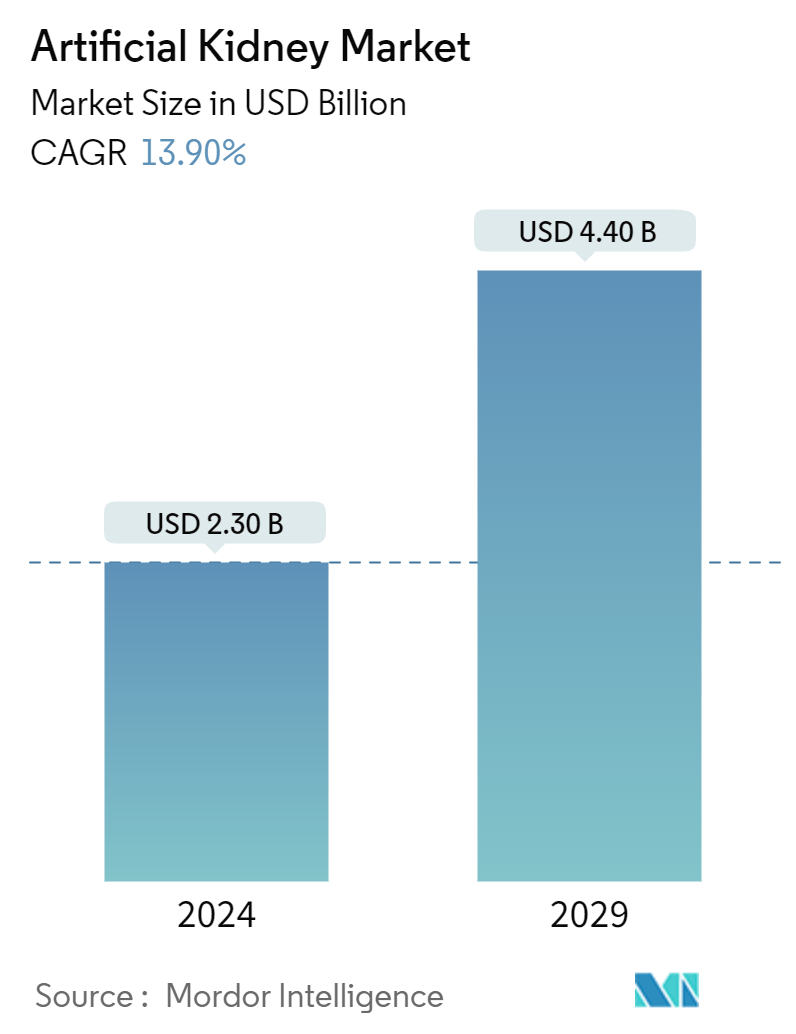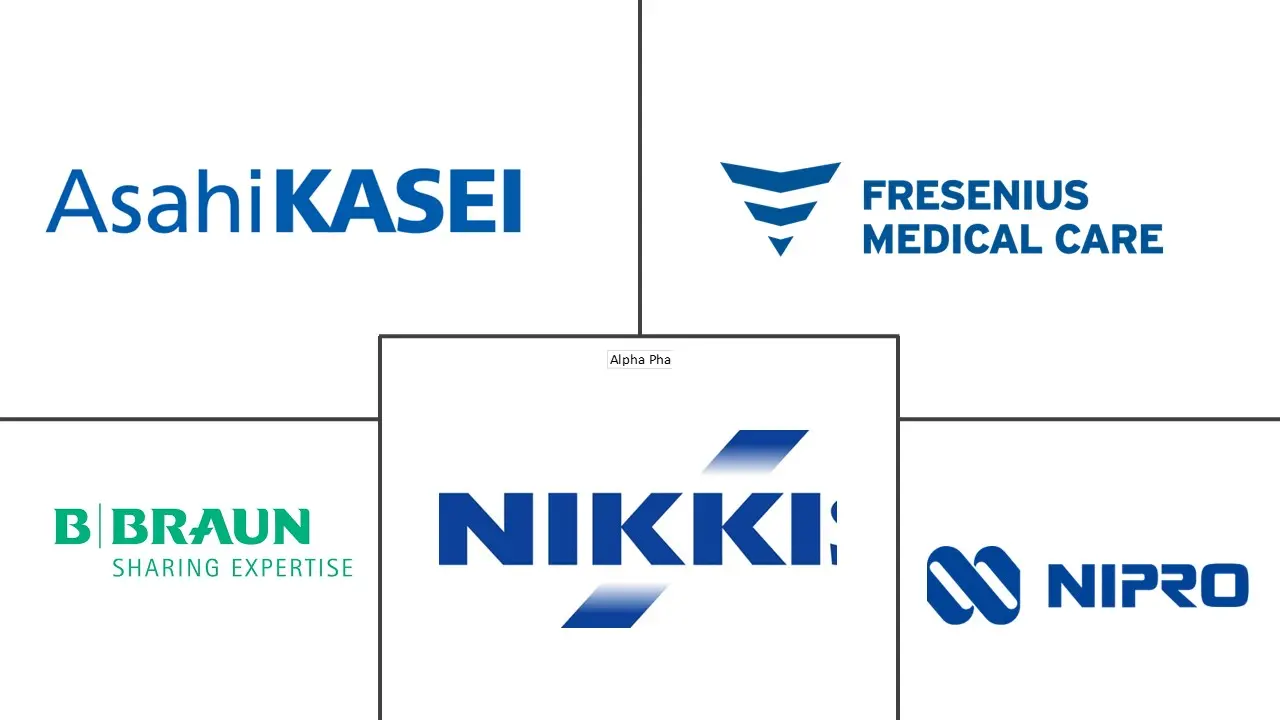Market Size of Artificial Kidney Industry

| Study Period | 2019 - 2029 |
| Market Size (2024) | USD 2.30 Billion |
| Market Size (2029) | USD 4.40 Billion |
| CAGR (2024 - 2029) | 13.90 % |
| Fastest Growing Market | Asia Pacific |
| Largest Market | North America |
Major Players
*Disclaimer: Major Players sorted in no particular order |
Artificial Kidney Market Analysis
The Artificial Kidney Market size is estimated at USD 2.30 billion in 2024, and is expected to reach USD 4.40 billion by 2029, growing at a CAGR of 13.90% during the forecast period (2024-2029).
The market is expected to grow owing to the surging burden of chronic kidney diseases, the scarcity of donors, and technological advances in artificial kidneys. In addition, supportive government legislation to promote the uptake of artificial kidneys is anticipated to boost market growth during the forecast period.
The growing burden of chronic diseases such as chronic kidney diseases, end-stage renal diseases, and kidney failure may drive the demand for artificial kidneys, as artificial kidneys are designed to work like the natural kidney, filtering the blood and maintaining the body's fluid balance. For instance, according to an article published by the Lancet Global Health in March 2024, chronic kidney disease emerged as a significant global issue and is estimated to affect around 10% of the global population.
In addition, the increased burden of chronic kidney conditions across developed countries is projected to fuel the demand for artificial kidneys for healthy living, which is further anticipated to boost market growth during the forecast period. For instance, according to May 2024 updated data from the Centers for Disease Control and Prevention (CDC), chronic kidney disease (CKD) is a significant burden in the United States, and around 35.5 million people, or 14% of the United States population have CKD in the country. Thus, such a remarkable burden of kidney disease is likely to fuel the demand for advanced treatment options like artificial kidneys.
The scarcity of kidney donors is expected to increase the demand for artificial kidneys for effective health management. For instance, according to the Kidney Foundation Funds Data updated in June 2024, more than 93,000 Americans were on the kidney transplant waiting list. Yet, only 27,332 among them were able to receive a kidney transplant. This indicates a huge scarcity of donors for kidney transplants, and thus, it is expected to boost the artificial kidney market during the forecast period.
Moreover, according to an article published by the Journal of Transplantation in March 2024, the scarcity of compatible living donors fuels the kidney transplant shortage and creates extended patient waiting times. Thus, the scarcity associated with kidney transplants and increased waiting times is anticipated to augment the development of artificial kidney products, which, in turn, is projected to boost market growth during the forecast period.
Thus, the above-mentioned factors, such as the surging burden of chronic kidney diseases, the scarcity of donors, and technological advances in artificial kidneys, are projected to accelerate industry uptake during the forecast period. However, the less penetration of artificial kidneys in developing and low- and middle-income countries and the higher cost of these kidneys are anticipated to hamper market growth during the forecast period.
Artificial Kidney Industry Segmentation
As per the scope of the report, the artificial kidney is a device known as a haemodialyzer that filters the blood of a person suffering from kidney disease. It helps to minimize chronic renal disease and improve patients' quality of life. An artificial kidney comprises silicon nano filters that remove water, salts, toxins, and other tiny molecules.
The artificial kidney market is segmented by device type and end user. The market is segmented by device type, such as wearable artificial kidney or implantable artificial kidney. By end user, the market is segmented as hospitals, specialty clinics, and ambulatory surgical centers. The report also covers the market sizes and forecasts for the artificial kidney market in major countries across different regions. For each segment, the market size is provided in terms of value (USD).
| By Device Type | |
| Wearable Artificial Kidney | |
| Implantable Artificial Kidney |
| By End User | |
| Hospitals | |
| Specialty Clinics | |
| Ambulatory Surgical Centers |
| Geography | ||||||||
| ||||||||
| ||||||||
| ||||||||
| ||||||||
|
Artificial Kidney Market Size Summary
The artificial kidney market is poised for significant growth, driven by the increasing prevalence of chronic kidney diseases and the scarcity of organ donors. Technological advancements in artificial kidney systems, coupled with supportive government legislation, are expected to further propel market expansion. The demand for artificial kidneys is particularly fueled by the rising incidence of conditions such as end-stage renal disease and kidney failure, which necessitate advanced treatment options. The shortage of compatible living donors and extended waiting times for kidney transplants underscore the need for artificial kidneys, enhancing their appeal as a viable solution for effective health management. Despite these growth drivers, challenges such as limited penetration in developing regions and the high cost of artificial kidneys may impede market progress.
The market for wearable artificial kidneys is anticipated to experience robust growth due to their ability to offer home dialysis, improving patient autonomy and reducing the need for hospital visits. This segment's expansion is supported by the growing prevalence of kidney diseases and strategic initiatives by market players to develop and launch portable kidney devices. North America is expected to hold a significant market share, attributed to the region's well-established healthcare infrastructure, high health spending, and the presence of key industry participants. Increased funding for artificial kidney research and development further bolsters regional market growth. The competitive landscape is characterized by numerous major players employing both organic and inorganic growth strategies, with collaborations and partnerships playing a crucial role in advancing renal health technologies.
Artificial Kidney Market Size - Table of Contents
-
1. MARKET DYNAMICS
-
1.1 Market Overview
-
1.2 Market Drivers
-
1.2.1 Increasing Incidence of Chronic Kidney Diseases
-
1.2.2 Scarcity of Donor Organs
-
1.2.3 Technological Advancements in the Artificial Kidney
-
-
1.3 Market Restraints
-
1.3.1 Expensive Procedures and Products
-
1.3.2 Risks Associated With Artificial Kidney
-
-
1.4 Porter's Five Forces Analysis
-
1.4.1 Threat of New Entrants
-
1.4.2 Bargaining Power of Buyers/Consumers
-
1.4.3 Bargaining Power of Suppliers
-
1.4.4 Threat of Substitute Products
-
1.4.5 Intensity of Competitive Rivalry
-
-
-
2. MARKET SEGMENTATION
-
2.1 By Device Type
-
2.1.1 Wearable Artificial Kidney
-
2.1.2 Implantable Artificial Kidney
-
-
2.2 By End User
-
2.2.1 Hospitals
-
2.2.2 Specialty Clinics
-
2.2.3 Ambulatory Surgical Centers
-
-
2.3 Geography
-
2.3.1 North America
-
2.3.1.1 United States
-
2.3.1.2 Canada
-
2.3.1.3 Mexico
-
-
2.3.2 Europe
-
2.3.2.1 Germany
-
2.3.2.2 United Kingdom
-
2.3.2.3 France
-
2.3.2.4 Italy
-
2.3.2.5 Spain
-
2.3.2.6 Rest of Europe
-
-
2.3.3 Asia-Pacific
-
2.3.3.1 China
-
2.3.3.2 Japan
-
2.3.3.3 India
-
2.3.3.4 Australia
-
2.3.3.5 South Korea
-
2.3.3.6 Rest of Asia-Pacific
-
-
2.3.4 Middle East and Africa
-
2.3.4.1 GCC
-
2.3.4.2 South Africa
-
2.3.4.3 Rest of Middle East and Africa
-
-
2.3.5 South America
-
2.3.5.1 Brazil
-
2.3.5.2 Argentina
-
2.3.5.3 Rest of South America
-
-
-
Artificial Kidney Market Size FAQs
How big is the Artificial Kidney Market?
The Artificial Kidney Market size is expected to reach USD 2.30 billion in 2024 and grow at a CAGR of 13.90% to reach USD 4.40 billion by 2029.
What is the current Artificial Kidney Market size?
In 2024, the Artificial Kidney Market size is expected to reach USD 2.30 billion.

